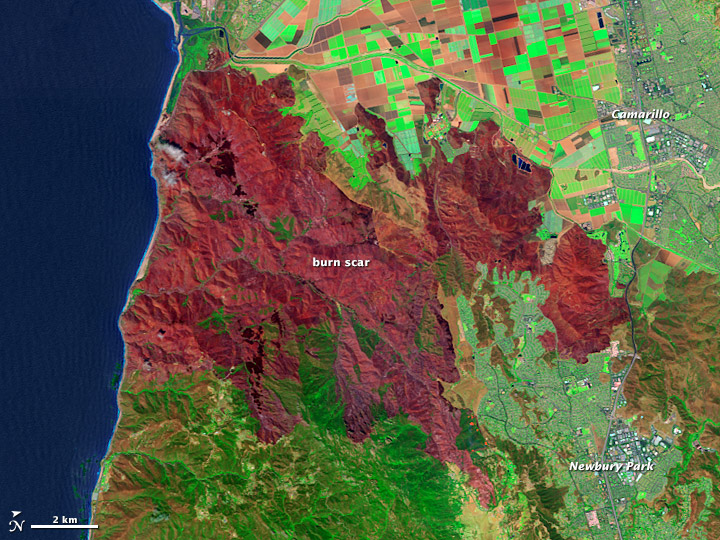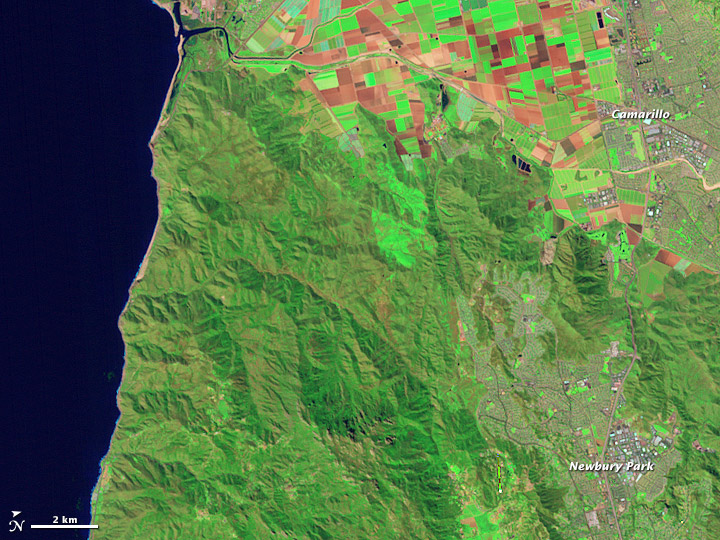NASA: US - California - Mapping the Severity of Springs Fire from Space - 09.05.13
Posted by Ricardo Marcenaro | Posted in NASA: US - California - Mapping the Severity of Springs Fire from Space - 09.05.13 | Posted on 17:54

acquired May 4, 2013
download large image (2 MB, JPEG, 2331x2331)
acquired May 4, 2013
download GeoTIFF file (2 MB, TIFF)

acquired March 18, 2010
download large image (2 MB, JPEG, 2331x2331)
acquired March 18, 2010
download GeoTIFF file (3 MB, TIFF)
acquired March 18, 2010 - May 4, 2013
download Google Earth file (KML)
On May 2, 2013, an explosive wildfire
ignited in southern California near Camarillo. Fueled by unusually dry
conditions and strong winds, the Springs Fire
blazed through more than 24,000 acres of chaparral on the Santa Monica
Mountains, forcing the closure of parts of Highway 101 and threatening
thousands of homes in Camarillo, Newbury Park, and Thousand Oaks.
Within a week, hundreds of firefighters had contained the fire,
limiting damage to just 16 buildings. That may seem like the end of the
story, but for Burned Area Emergency Response (BAER) teams, the work just begins when the flames die down.
BAER teams often head for the field while the remnants of a fire are
still smoldering. These multidisciplinary groups of scientists—which
include hydrologists, wildlife biologists, soil scientists, geologists,
engineers, botanists, ecologists, and foresters—evaluate the severity of
a fire and look for additional threats. The risk of floods, severe
erosion, and landslides often increases because wildfires consume leaf
litter and other organic matter that normally soak up and retain
moisture. Vaporized oils from charred leaves also can leave a
water-repellent sheen on the soil that causes water to run-off.
It’s the job of the BAER team to spot such risks as quickly as
possible so emergency planners can begin developing responses. The
obvious way to do this is to investigate with people on the ground.
However, there are times when fires are so large and inaccessible, or
when resources are stretched so thin, that BAER teams can’t get to all
the fires. Since about 2001, BAER teams have gotten help from some eyes
in the sky.
Satellite sensors collect data in a variety of wavelengths within the electromagnetic spectrum, some far beyond what the human eye can detect. Certain wavelengths in shortwave and near infrared
are especially useful for gauging the severity of a fire. If a
satellite passes over at the right time, remote-sensing experts can
produce maps of burn severity within hours of the blaze.
The Landsat Data Continuity Mission (LDCM), the newest Landsat satellite, passed over the Springs Fire on May 4, 2013. In the false-color images above from LDCM’s Operational Land Imager
(OLI), unburned vegetation appears dark green. Burned areas are red,
and the most severely burned areas are generally the darkest. Actively
growing farmland is light green; plowed fields are brown. Buildings and
roads are gray. Note that the image is rotated so that north is to the
right.
While most of the Springs Fire affected shrubland
and forested areas, flames did encroach on fields and homes near
Camarillo and Newbury Park. The lower image shows the same area on March
18, 2010. (Turn on the image-comparison tool to see the difference.)
“Having a new Landsat satellite on orbit is critically important. We
have to deliver our maps to the BAER teams within a week for them to be
most useful, and our odds of getting timely high-quality cloud and
smoke-free image acquisitions just went up dramatically.” said Randy
McKinley, a geographer with the U.S. Geological Survey’s Earth Resources Observation and Science (EROS) Center who makes burn severity maps.
“With the recent loss of Landsat 5, we were limited to one Landsat overpass every 16 days for most fires. With the successful launch
of LDCM, we will now be getting a look at wildfires at least every 8
days,” he said. In addition, LDCM is expected to collect more than 400
scenes per day; instruments on Landsat 5 and 7 collected about 250.
Note that the images above are considered engineering data—they help
LDCM scientists and engineers ensure that the satellite and its
instruments are operating as designed. Once LDCM completes its check-out
period and becomes fully operational for science, NASA will pass
control of the satellite to the U.S. Geological Survey and LDCM will be
re-named Landsat 8.
References
- Cal Fire (2013, May 8) Springs Fire. Accessed May 8, 2013.
- Earth Observatory (2002, October 23) Satellites Aid Burned Area Emergency Rehabilitation.
- National Interagency Fire Center. BAER: Burned Area Emergency Response. Accessed May 8, 2013.
- NASA Goddard Space Flight Center. The Landsat Program. Accessed May 8, 2013.
- NBC (2013, May 6) Roadside Brush That Ignited Springs Fire Was Cleared Two Weeks Earlier. Accessed May 8, 2013.
Further Reading
- NASA (2011, August 23) Landsat Maps Aid Fire Recovery Efforts. Accessed May 8, 2013.
- Parsons. A & Orlemann, A. Mapping Post-Wildfire Burn Severity Using Remote Sensing and GIS. Accessed May 8, 2013.
- Wildland Fire Leadership Council. Monitoring Trends in Burns Severity (MTBS). Accessed May 8, 2013.
Images by Robert Simmon, using data from the U.S. Geological Survey and NASA. Caption by Adam Voiland.
- Instrument:
- Landsat 8 - OLI
NASA: US - California - Mapping the Severity of Springs Fire from Space - 09.05.13
Ricardo Marcenaro
Sculptures – Esculturas
http://ricardomarcenaro.ning.com/
Ricardo M Marcenaro - Facebook
Blogs in operation of The Solitary Dog:
Solitary Dog Sculptor:
http://byricardomarcenaro.blogspot.com
Solitary Dog Sculptor I:
http://byricardomarcenaroi.blogspot.com
Para:
comunicarse conmigo,
enviar materiales para publicar,
propuestas comerciales:
marcenaroescultor@gmail.com
For:
contact me,
submit materials for publication,
commercial proposals:
marcenaroescultor@gmail.com
Diario La Nación
Argentina
Cuenta Comentarista en el Foro:
Capiscum
My blogs are an open house to all cultures, religions and countries. Be a follower if you like it, with this action you are building a new culture of tolerance, open mind and heart for peace, love and human respect.
Thanks :)
Mis blogs son una casa abierta a todas las culturas, religiones y países. Se un seguidor si quieres, con esta acción usted está construyendo una nueva cultura de la tolerancia, la mente y el corazón abiertos para la paz, el amor y el respeto humano.
Gracias :)


Comments (0)
Publicar un comentario